Financial Performance Analysis of BHP Billiton using Ratio Analysis
VerifiedAdded on 2019/11/20
|12
|2514
|255
Report
AI Summary
This report provides a comprehensive financial performance analysis of BHP Billiton from 2012 to 2016, focusing on the impact of fluctuating commodity prices on the company's financial health. The analysis utilizes ratio analysis to assess profitability, efficiency, liquidity, and solvency. The report highlights the significant influence of commodity prices on BHP Billiton's profitability, particularly the decline in profits and the operating loss in FY2016 due to falling prices. It also examines the company's efforts to improve efficiency and manage its cash cycle, with positive results observed in inventory and receivables turnover. The study further investigates the company's liquidity and solvency ratios, revealing improvements in short-term liquidity but a deterioration in long-term solvency, especially in FY2016. The conclusion emphasizes the cyclical nature of the mining industry and the importance of commodity prices in determining BHP Billiton's financial outcomes. This report offers valuable insights into the financial strategies and performance of a leading mining company during a period of industry turbulence.
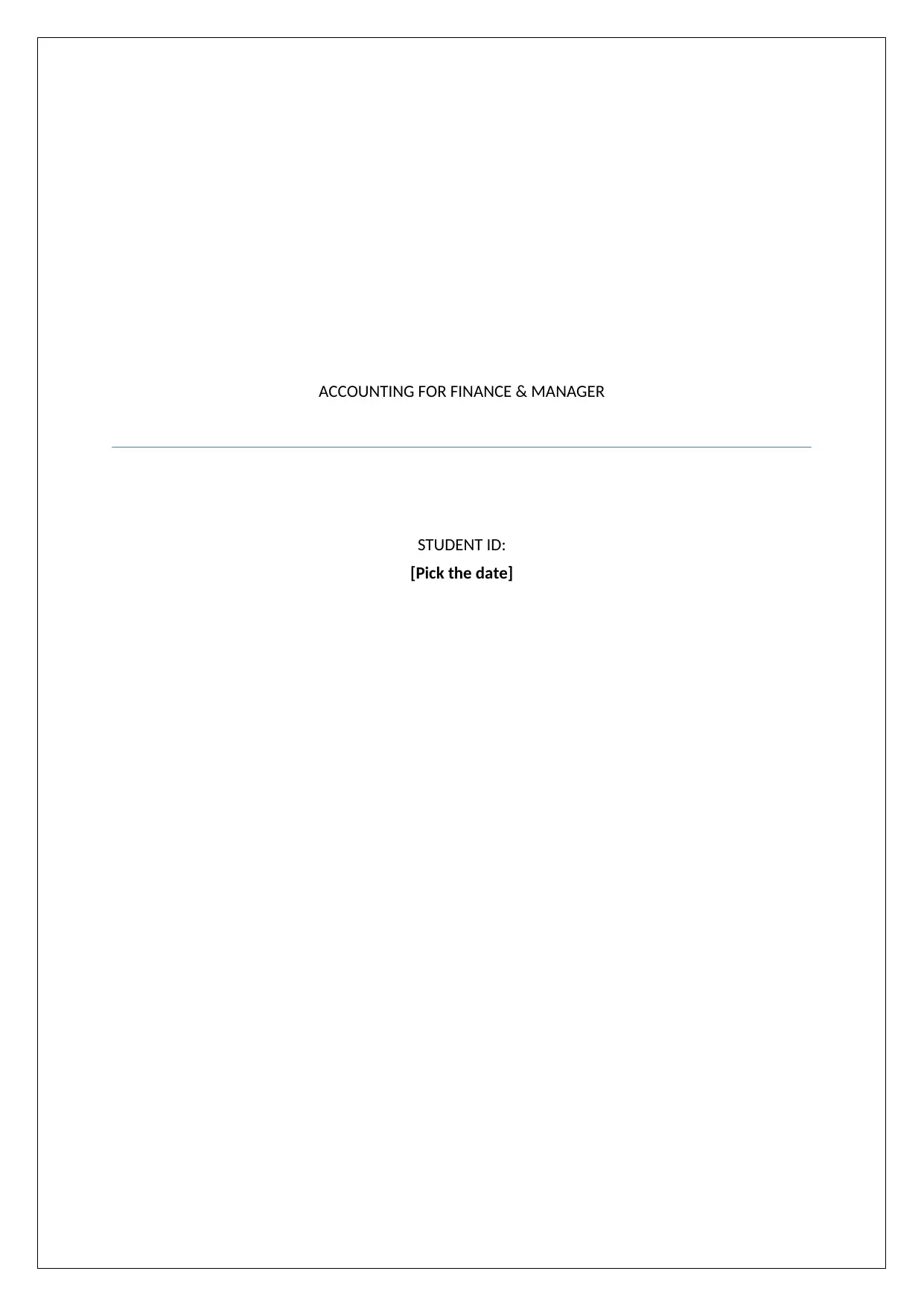
ACCOUNTING FOR FINANCE & MANAGER
STUDENT ID:
[Pick the date]
STUDENT ID:
[Pick the date]
Paraphrase This Document
Need a fresh take? Get an instant paraphrase of this document with our AI Paraphraser
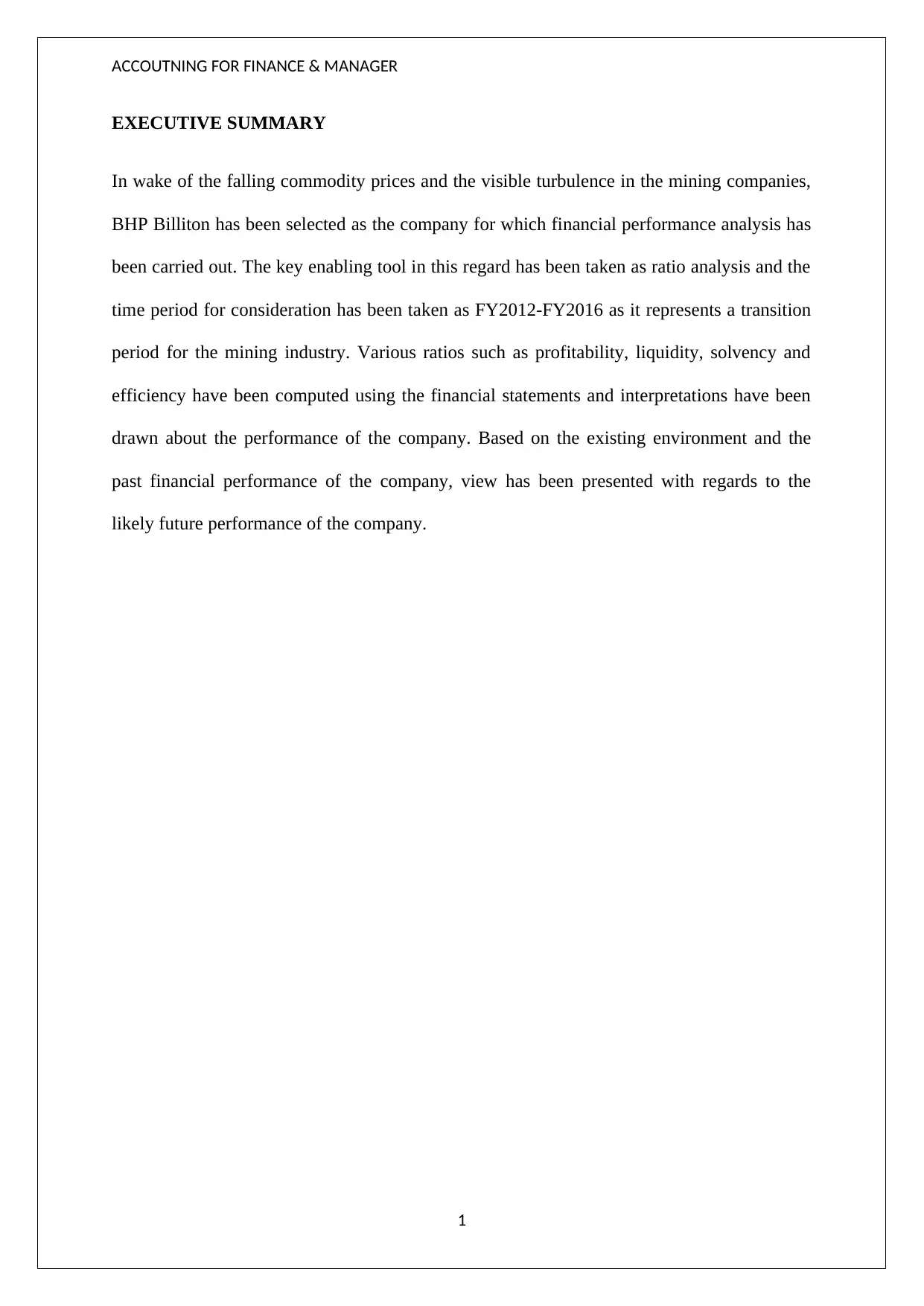
ACCOUTNING FOR FINANCE & MANAGER
EXECUTIVE SUMMARY
In wake of the falling commodity prices and the visible turbulence in the mining companies,
BHP Billiton has been selected as the company for which financial performance analysis has
been carried out. The key enabling tool in this regard has been taken as ratio analysis and the
time period for consideration has been taken as FY2012-FY2016 as it represents a transition
period for the mining industry. Various ratios such as profitability, liquidity, solvency and
efficiency have been computed using the financial statements and interpretations have been
drawn about the performance of the company. Based on the existing environment and the
past financial performance of the company, view has been presented with regards to the
likely future performance of the company.
1
EXECUTIVE SUMMARY
In wake of the falling commodity prices and the visible turbulence in the mining companies,
BHP Billiton has been selected as the company for which financial performance analysis has
been carried out. The key enabling tool in this regard has been taken as ratio analysis and the
time period for consideration has been taken as FY2012-FY2016 as it represents a transition
period for the mining industry. Various ratios such as profitability, liquidity, solvency and
efficiency have been computed using the financial statements and interpretations have been
drawn about the performance of the company. Based on the existing environment and the
past financial performance of the company, view has been presented with regards to the
likely future performance of the company.
1
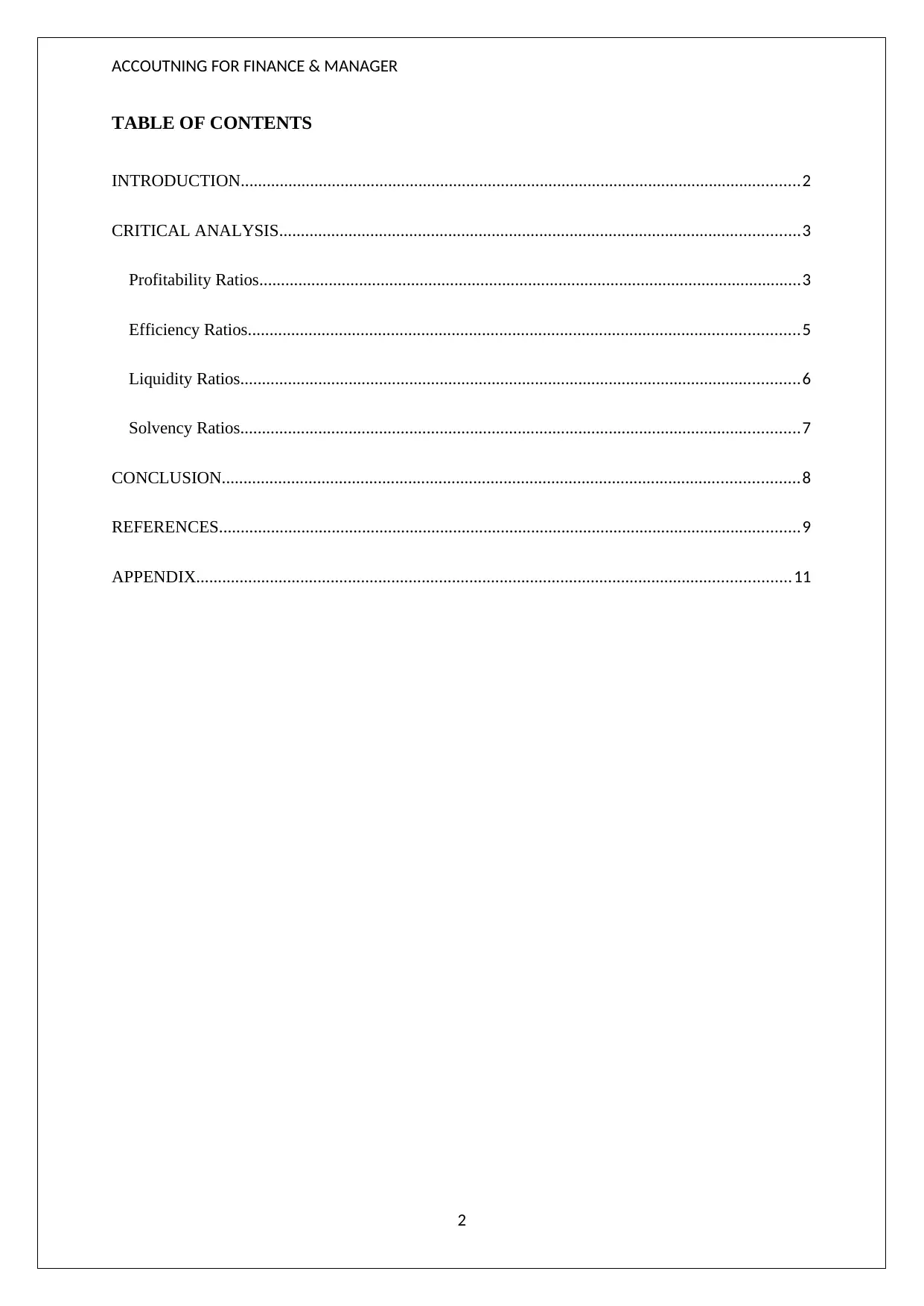
ACCOUTNING FOR FINANCE & MANAGER
TABLE OF CONTENTS
INTRODUCTION.................................................................................................................................2
CRITICAL ANALYSIS........................................................................................................................3
Profitability Ratios.............................................................................................................................3
Efficiency Ratios...............................................................................................................................5
Liquidity Ratios.................................................................................................................................6
Solvency Ratios.................................................................................................................................7
CONCLUSION.....................................................................................................................................8
REFERENCES......................................................................................................................................9
APPENDIX.........................................................................................................................................11
2
TABLE OF CONTENTS
INTRODUCTION.................................................................................................................................2
CRITICAL ANALYSIS........................................................................................................................3
Profitability Ratios.............................................................................................................................3
Efficiency Ratios...............................................................................................................................5
Liquidity Ratios.................................................................................................................................6
Solvency Ratios.................................................................................................................................7
CONCLUSION.....................................................................................................................................8
REFERENCES......................................................................................................................................9
APPENDIX.........................................................................................................................................11
2
⊘ This is a preview!⊘
Do you want full access?
Subscribe today to unlock all pages.

Trusted by 1+ million students worldwide
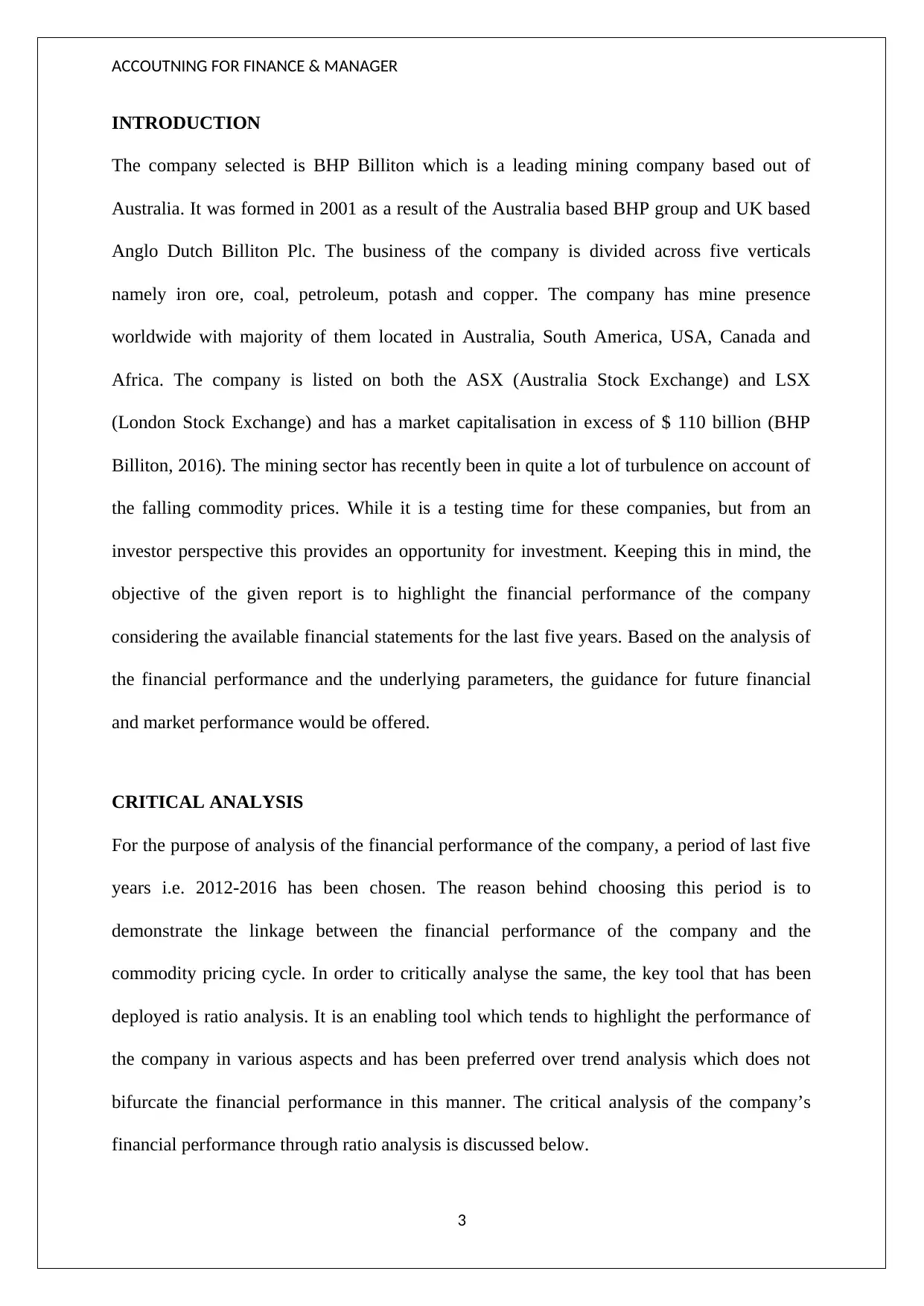
ACCOUTNING FOR FINANCE & MANAGER
INTRODUCTION
The company selected is BHP Billiton which is a leading mining company based out of
Australia. It was formed in 2001 as a result of the Australia based BHP group and UK based
Anglo Dutch Billiton Plc. The business of the company is divided across five verticals
namely iron ore, coal, petroleum, potash and copper. The company has mine presence
worldwide with majority of them located in Australia, South America, USA, Canada and
Africa. The company is listed on both the ASX (Australia Stock Exchange) and LSX
(London Stock Exchange) and has a market capitalisation in excess of $ 110 billion (BHP
Billiton, 2016). The mining sector has recently been in quite a lot of turbulence on account of
the falling commodity prices. While it is a testing time for these companies, but from an
investor perspective this provides an opportunity for investment. Keeping this in mind, the
objective of the given report is to highlight the financial performance of the company
considering the available financial statements for the last five years. Based on the analysis of
the financial performance and the underlying parameters, the guidance for future financial
and market performance would be offered.
CRITICAL ANALYSIS
For the purpose of analysis of the financial performance of the company, a period of last five
years i.e. 2012-2016 has been chosen. The reason behind choosing this period is to
demonstrate the linkage between the financial performance of the company and the
commodity pricing cycle. In order to critically analyse the same, the key tool that has been
deployed is ratio analysis. It is an enabling tool which tends to highlight the performance of
the company in various aspects and has been preferred over trend analysis which does not
bifurcate the financial performance in this manner. The critical analysis of the company’s
financial performance through ratio analysis is discussed below.
3
INTRODUCTION
The company selected is BHP Billiton which is a leading mining company based out of
Australia. It was formed in 2001 as a result of the Australia based BHP group and UK based
Anglo Dutch Billiton Plc. The business of the company is divided across five verticals
namely iron ore, coal, petroleum, potash and copper. The company has mine presence
worldwide with majority of them located in Australia, South America, USA, Canada and
Africa. The company is listed on both the ASX (Australia Stock Exchange) and LSX
(London Stock Exchange) and has a market capitalisation in excess of $ 110 billion (BHP
Billiton, 2016). The mining sector has recently been in quite a lot of turbulence on account of
the falling commodity prices. While it is a testing time for these companies, but from an
investor perspective this provides an opportunity for investment. Keeping this in mind, the
objective of the given report is to highlight the financial performance of the company
considering the available financial statements for the last five years. Based on the analysis of
the financial performance and the underlying parameters, the guidance for future financial
and market performance would be offered.
CRITICAL ANALYSIS
For the purpose of analysis of the financial performance of the company, a period of last five
years i.e. 2012-2016 has been chosen. The reason behind choosing this period is to
demonstrate the linkage between the financial performance of the company and the
commodity pricing cycle. In order to critically analyse the same, the key tool that has been
deployed is ratio analysis. It is an enabling tool which tends to highlight the performance of
the company in various aspects and has been preferred over trend analysis which does not
bifurcate the financial performance in this manner. The critical analysis of the company’s
financial performance through ratio analysis is discussed below.
3
Paraphrase This Document
Need a fresh take? Get an instant paraphrase of this document with our AI Paraphraser
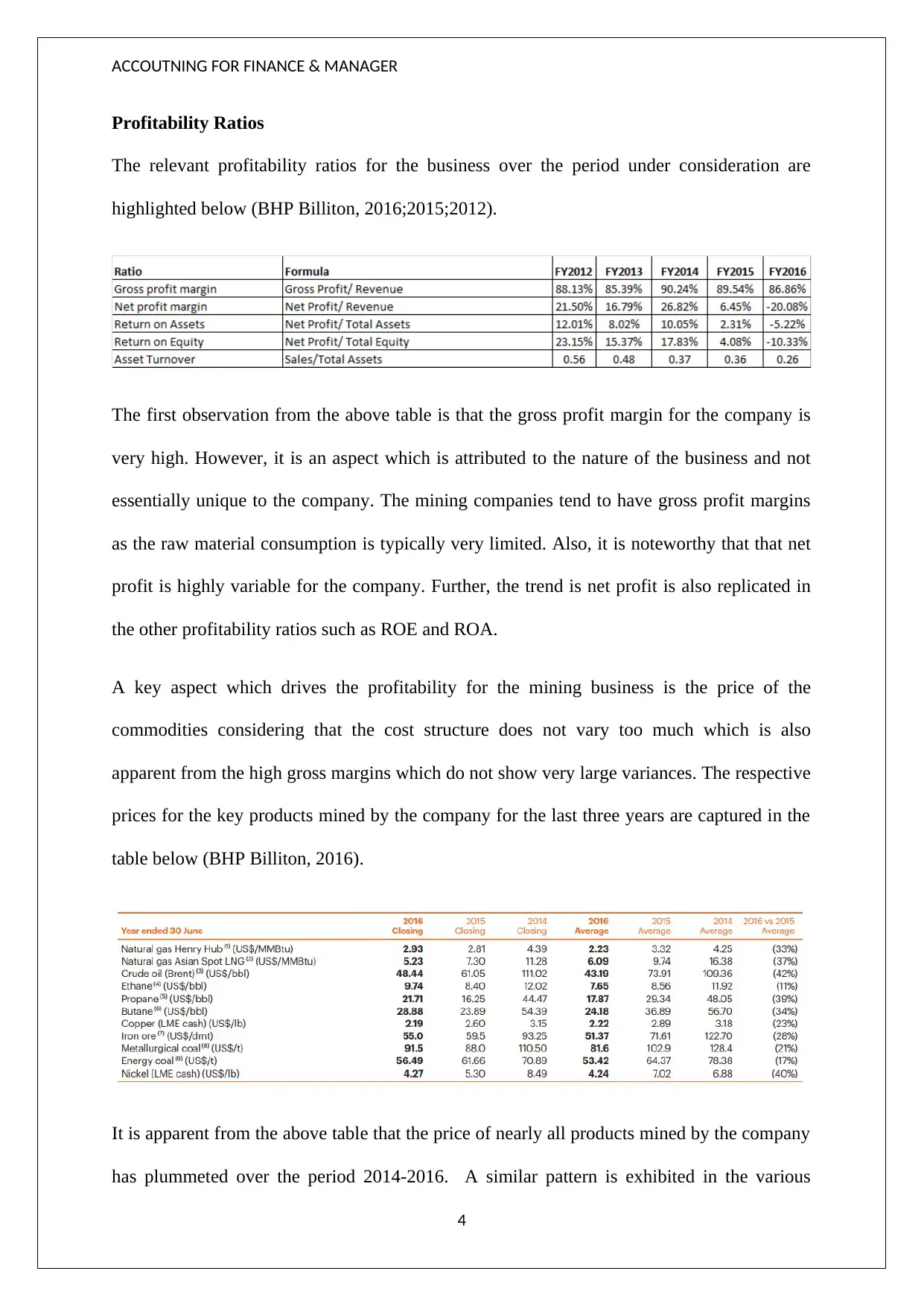
ACCOUTNING FOR FINANCE & MANAGER
Profitability Ratios
The relevant profitability ratios for the business over the period under consideration are
highlighted below (BHP Billiton, 2016;2015;2012).
The first observation from the above table is that the gross profit margin for the company is
very high. However, it is an aspect which is attributed to the nature of the business and not
essentially unique to the company. The mining companies tend to have gross profit margins
as the raw material consumption is typically very limited. Also, it is noteworthy that that net
profit is highly variable for the company. Further, the trend is net profit is also replicated in
the other profitability ratios such as ROE and ROA.
A key aspect which drives the profitability for the mining business is the price of the
commodities considering that the cost structure does not vary too much which is also
apparent from the high gross margins which do not show very large variances. The respective
prices for the key products mined by the company for the last three years are captured in the
table below (BHP Billiton, 2016).
It is apparent from the above table that the price of nearly all products mined by the company
has plummeted over the period 2014-2016. A similar pattern is exhibited in the various
4
Profitability Ratios
The relevant profitability ratios for the business over the period under consideration are
highlighted below (BHP Billiton, 2016;2015;2012).
The first observation from the above table is that the gross profit margin for the company is
very high. However, it is an aspect which is attributed to the nature of the business and not
essentially unique to the company. The mining companies tend to have gross profit margins
as the raw material consumption is typically very limited. Also, it is noteworthy that that net
profit is highly variable for the company. Further, the trend is net profit is also replicated in
the other profitability ratios such as ROE and ROA.
A key aspect which drives the profitability for the mining business is the price of the
commodities considering that the cost structure does not vary too much which is also
apparent from the high gross margins which do not show very large variances. The respective
prices for the key products mined by the company for the last three years are captured in the
table below (BHP Billiton, 2016).
It is apparent from the above table that the price of nearly all products mined by the company
has plummeted over the period 2014-2016. A similar pattern is exhibited in the various
4
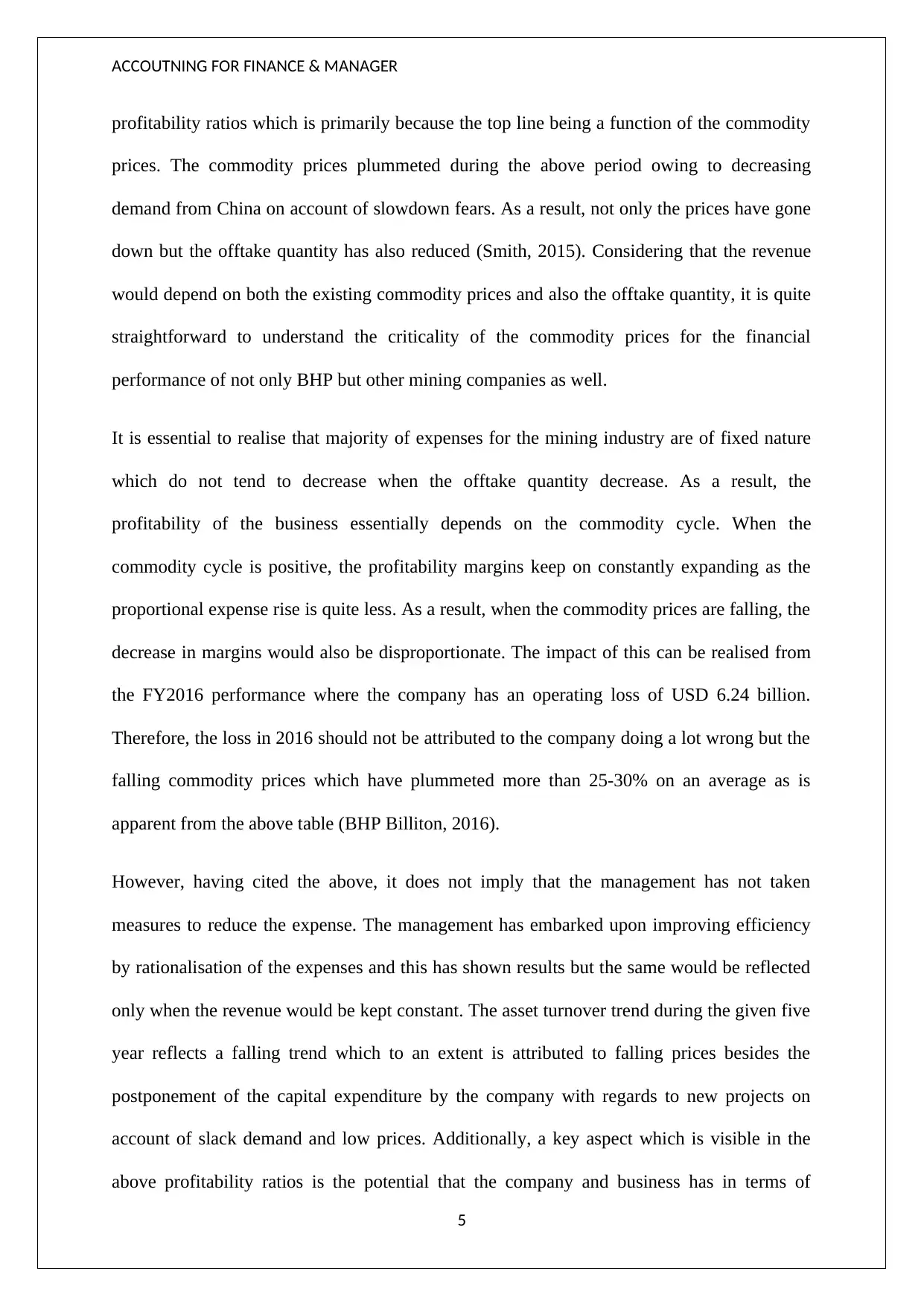
ACCOUTNING FOR FINANCE & MANAGER
profitability ratios which is primarily because the top line being a function of the commodity
prices. The commodity prices plummeted during the above period owing to decreasing
demand from China on account of slowdown fears. As a result, not only the prices have gone
down but the offtake quantity has also reduced (Smith, 2015). Considering that the revenue
would depend on both the existing commodity prices and also the offtake quantity, it is quite
straightforward to understand the criticality of the commodity prices for the financial
performance of not only BHP but other mining companies as well.
It is essential to realise that majority of expenses for the mining industry are of fixed nature
which do not tend to decrease when the offtake quantity decrease. As a result, the
profitability of the business essentially depends on the commodity cycle. When the
commodity cycle is positive, the profitability margins keep on constantly expanding as the
proportional expense rise is quite less. As a result, when the commodity prices are falling, the
decrease in margins would also be disproportionate. The impact of this can be realised from
the FY2016 performance where the company has an operating loss of USD 6.24 billion.
Therefore, the loss in 2016 should not be attributed to the company doing a lot wrong but the
falling commodity prices which have plummeted more than 25-30% on an average as is
apparent from the above table (BHP Billiton, 2016).
However, having cited the above, it does not imply that the management has not taken
measures to reduce the expense. The management has embarked upon improving efficiency
by rationalisation of the expenses and this has shown results but the same would be reflected
only when the revenue would be kept constant. The asset turnover trend during the given five
year reflects a falling trend which to an extent is attributed to falling prices besides the
postponement of the capital expenditure by the company with regards to new projects on
account of slack demand and low prices. Additionally, a key aspect which is visible in the
above profitability ratios is the potential that the company and business has in terms of
5
profitability ratios which is primarily because the top line being a function of the commodity
prices. The commodity prices plummeted during the above period owing to decreasing
demand from China on account of slowdown fears. As a result, not only the prices have gone
down but the offtake quantity has also reduced (Smith, 2015). Considering that the revenue
would depend on both the existing commodity prices and also the offtake quantity, it is quite
straightforward to understand the criticality of the commodity prices for the financial
performance of not only BHP but other mining companies as well.
It is essential to realise that majority of expenses for the mining industry are of fixed nature
which do not tend to decrease when the offtake quantity decrease. As a result, the
profitability of the business essentially depends on the commodity cycle. When the
commodity cycle is positive, the profitability margins keep on constantly expanding as the
proportional expense rise is quite less. As a result, when the commodity prices are falling, the
decrease in margins would also be disproportionate. The impact of this can be realised from
the FY2016 performance where the company has an operating loss of USD 6.24 billion.
Therefore, the loss in 2016 should not be attributed to the company doing a lot wrong but the
falling commodity prices which have plummeted more than 25-30% on an average as is
apparent from the above table (BHP Billiton, 2016).
However, having cited the above, it does not imply that the management has not taken
measures to reduce the expense. The management has embarked upon improving efficiency
by rationalisation of the expenses and this has shown results but the same would be reflected
only when the revenue would be kept constant. The asset turnover trend during the given five
year reflects a falling trend which to an extent is attributed to falling prices besides the
postponement of the capital expenditure by the company with regards to new projects on
account of slack demand and low prices. Additionally, a key aspect which is visible in the
above profitability ratios is the potential that the company and business has in terms of
5
⊘ This is a preview!⊘
Do you want full access?
Subscribe today to unlock all pages.

Trusted by 1+ million students worldwide
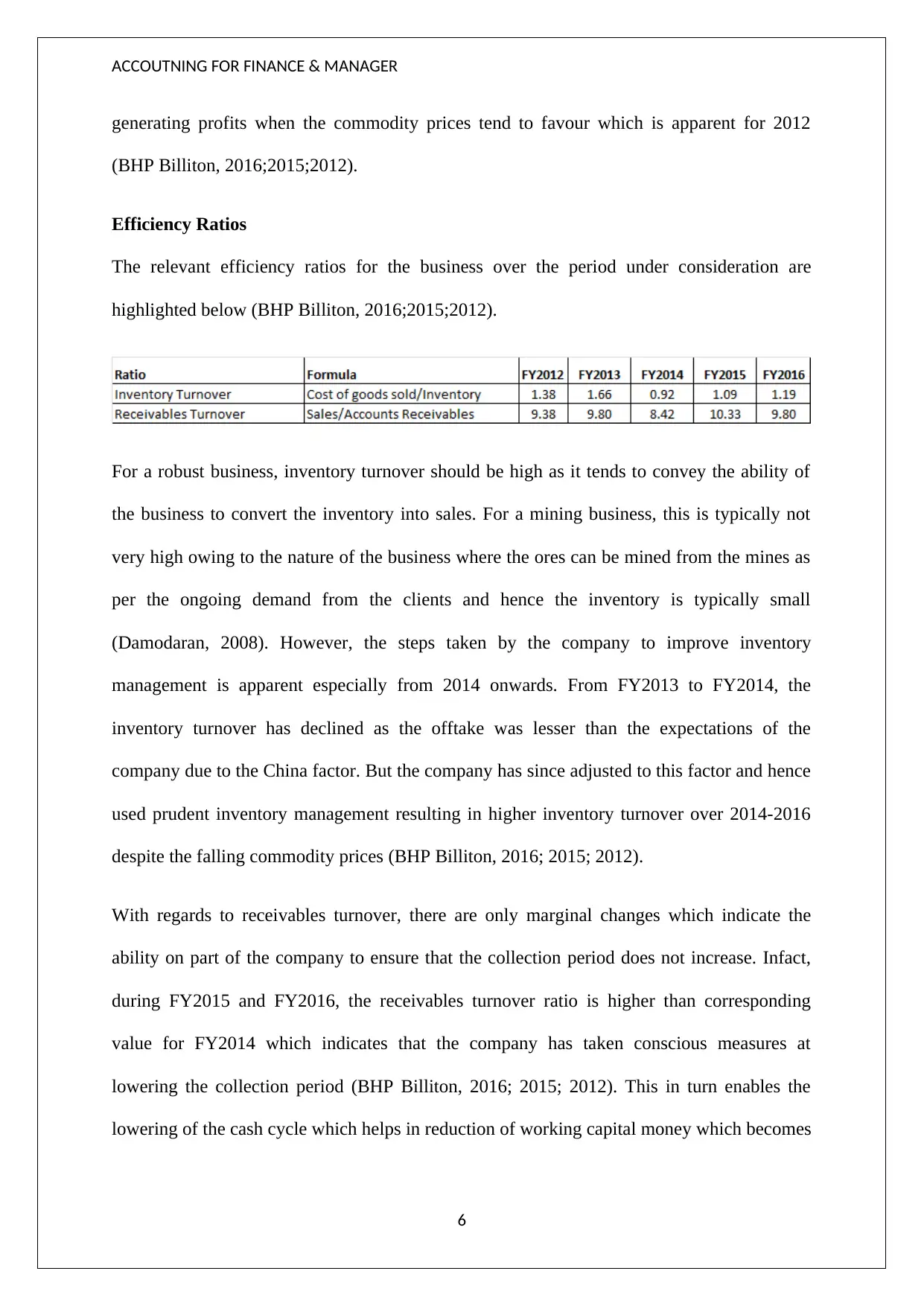
ACCOUTNING FOR FINANCE & MANAGER
generating profits when the commodity prices tend to favour which is apparent for 2012
(BHP Billiton, 2016;2015;2012).
Efficiency Ratios
The relevant efficiency ratios for the business over the period under consideration are
highlighted below (BHP Billiton, 2016;2015;2012).
For a robust business, inventory turnover should be high as it tends to convey the ability of
the business to convert the inventory into sales. For a mining business, this is typically not
very high owing to the nature of the business where the ores can be mined from the mines as
per the ongoing demand from the clients and hence the inventory is typically small
(Damodaran, 2008). However, the steps taken by the company to improve inventory
management is apparent especially from 2014 onwards. From FY2013 to FY2014, the
inventory turnover has declined as the offtake was lesser than the expectations of the
company due to the China factor. But the company has since adjusted to this factor and hence
used prudent inventory management resulting in higher inventory turnover over 2014-2016
despite the falling commodity prices (BHP Billiton, 2016; 2015; 2012).
With regards to receivables turnover, there are only marginal changes which indicate the
ability on part of the company to ensure that the collection period does not increase. Infact,
during FY2015 and FY2016, the receivables turnover ratio is higher than corresponding
value for FY2014 which indicates that the company has taken conscious measures at
lowering the collection period (BHP Billiton, 2016; 2015; 2012). This in turn enables the
lowering of the cash cycle which helps in reduction of working capital money which becomes
6
generating profits when the commodity prices tend to favour which is apparent for 2012
(BHP Billiton, 2016;2015;2012).
Efficiency Ratios
The relevant efficiency ratios for the business over the period under consideration are
highlighted below (BHP Billiton, 2016;2015;2012).
For a robust business, inventory turnover should be high as it tends to convey the ability of
the business to convert the inventory into sales. For a mining business, this is typically not
very high owing to the nature of the business where the ores can be mined from the mines as
per the ongoing demand from the clients and hence the inventory is typically small
(Damodaran, 2008). However, the steps taken by the company to improve inventory
management is apparent especially from 2014 onwards. From FY2013 to FY2014, the
inventory turnover has declined as the offtake was lesser than the expectations of the
company due to the China factor. But the company has since adjusted to this factor and hence
used prudent inventory management resulting in higher inventory turnover over 2014-2016
despite the falling commodity prices (BHP Billiton, 2016; 2015; 2012).
With regards to receivables turnover, there are only marginal changes which indicate the
ability on part of the company to ensure that the collection period does not increase. Infact,
during FY2015 and FY2016, the receivables turnover ratio is higher than corresponding
value for FY2014 which indicates that the company has taken conscious measures at
lowering the collection period (BHP Billiton, 2016; 2015; 2012). This in turn enables the
lowering of the cash cycle which helps in reduction of working capital money which becomes
6
Paraphrase This Document
Need a fresh take? Get an instant paraphrase of this document with our AI Paraphraser
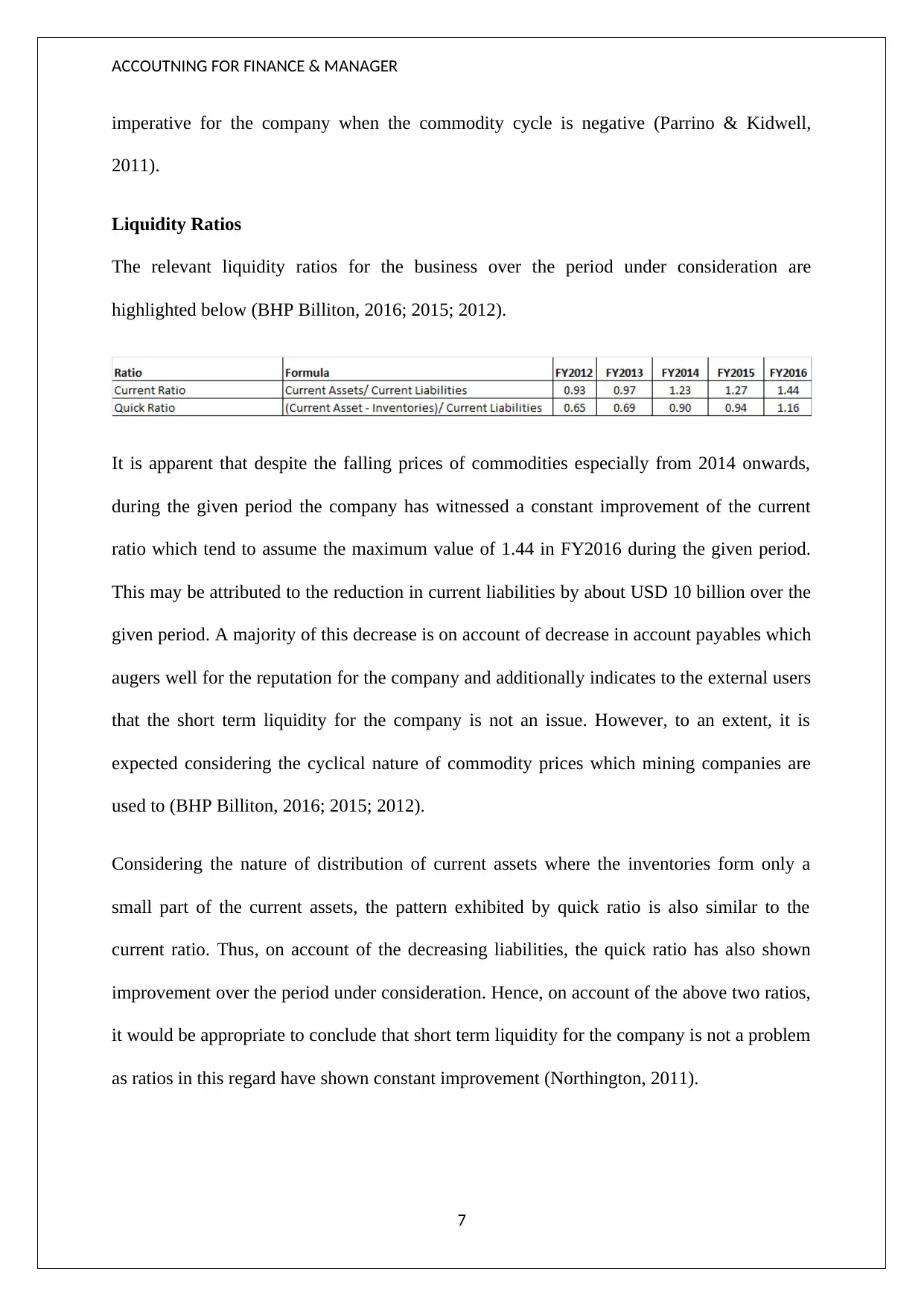
ACCOUTNING FOR FINANCE & MANAGER
imperative for the company when the commodity cycle is negative (Parrino & Kidwell,
2011).
Liquidity Ratios
The relevant liquidity ratios for the business over the period under consideration are
highlighted below (BHP Billiton, 2016; 2015; 2012).
It is apparent that despite the falling prices of commodities especially from 2014 onwards,
during the given period the company has witnessed a constant improvement of the current
ratio which tend to assume the maximum value of 1.44 in FY2016 during the given period.
This may be attributed to the reduction in current liabilities by about USD 10 billion over the
given period. A majority of this decrease is on account of decrease in account payables which
augers well for the reputation for the company and additionally indicates to the external users
that the short term liquidity for the company is not an issue. However, to an extent, it is
expected considering the cyclical nature of commodity prices which mining companies are
used to (BHP Billiton, 2016; 2015; 2012).
Considering the nature of distribution of current assets where the inventories form only a
small part of the current assets, the pattern exhibited by quick ratio is also similar to the
current ratio. Thus, on account of the decreasing liabilities, the quick ratio has also shown
improvement over the period under consideration. Hence, on account of the above two ratios,
it would be appropriate to conclude that short term liquidity for the company is not a problem
as ratios in this regard have shown constant improvement (Northington, 2011).
7
imperative for the company when the commodity cycle is negative (Parrino & Kidwell,
2011).
Liquidity Ratios
The relevant liquidity ratios for the business over the period under consideration are
highlighted below (BHP Billiton, 2016; 2015; 2012).
It is apparent that despite the falling prices of commodities especially from 2014 onwards,
during the given period the company has witnessed a constant improvement of the current
ratio which tend to assume the maximum value of 1.44 in FY2016 during the given period.
This may be attributed to the reduction in current liabilities by about USD 10 billion over the
given period. A majority of this decrease is on account of decrease in account payables which
augers well for the reputation for the company and additionally indicates to the external users
that the short term liquidity for the company is not an issue. However, to an extent, it is
expected considering the cyclical nature of commodity prices which mining companies are
used to (BHP Billiton, 2016; 2015; 2012).
Considering the nature of distribution of current assets where the inventories form only a
small part of the current assets, the pattern exhibited by quick ratio is also similar to the
current ratio. Thus, on account of the decreasing liabilities, the quick ratio has also shown
improvement over the period under consideration. Hence, on account of the above two ratios,
it would be appropriate to conclude that short term liquidity for the company is not a problem
as ratios in this regard have shown constant improvement (Northington, 2011).
7
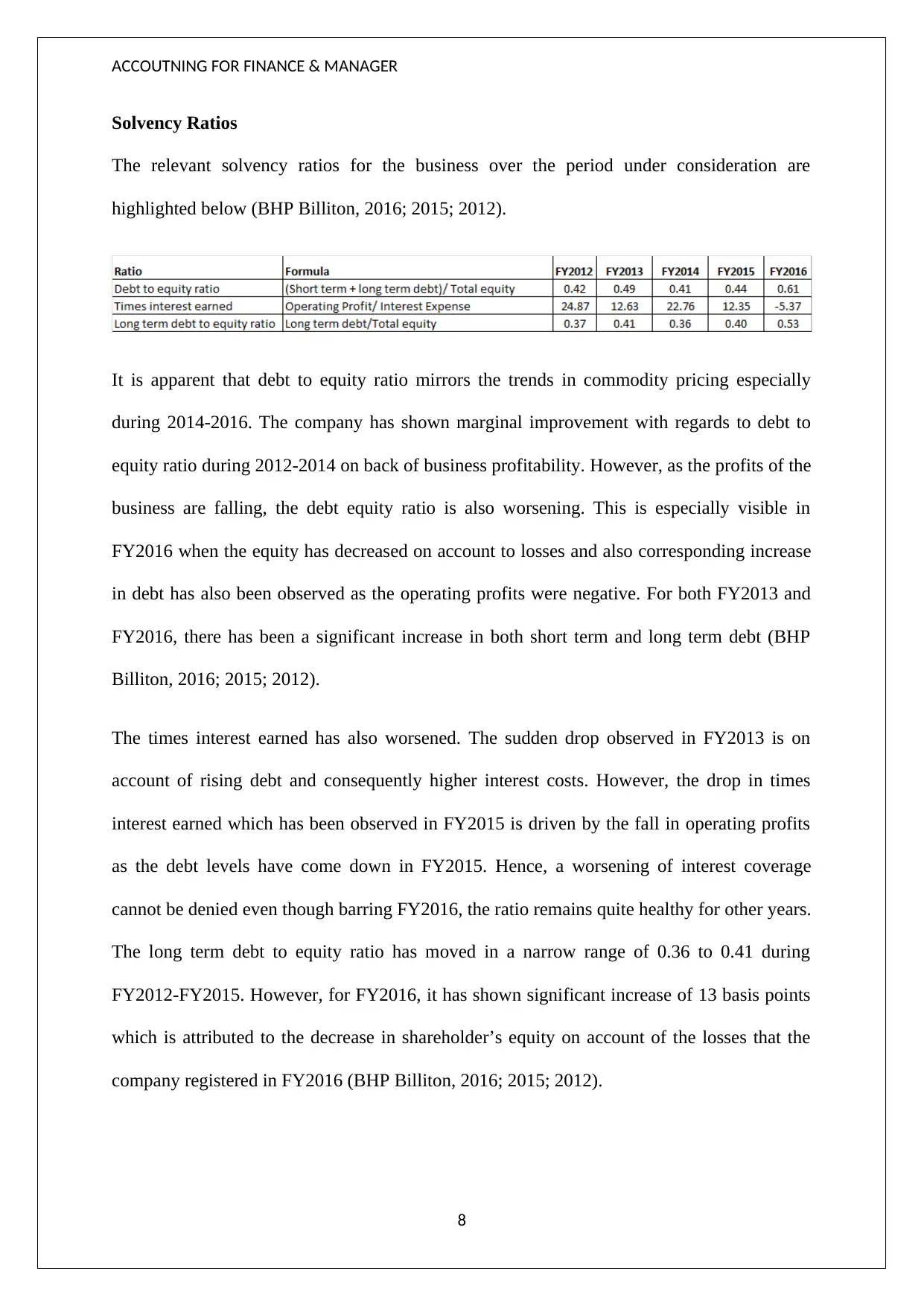
ACCOUTNING FOR FINANCE & MANAGER
Solvency Ratios
The relevant solvency ratios for the business over the period under consideration are
highlighted below (BHP Billiton, 2016; 2015; 2012).
It is apparent that debt to equity ratio mirrors the trends in commodity pricing especially
during 2014-2016. The company has shown marginal improvement with regards to debt to
equity ratio during 2012-2014 on back of business profitability. However, as the profits of the
business are falling, the debt equity ratio is also worsening. This is especially visible in
FY2016 when the equity has decreased on account to losses and also corresponding increase
in debt has also been observed as the operating profits were negative. For both FY2013 and
FY2016, there has been a significant increase in both short term and long term debt (BHP
Billiton, 2016; 2015; 2012).
The times interest earned has also worsened. The sudden drop observed in FY2013 is on
account of rising debt and consequently higher interest costs. However, the drop in times
interest earned which has been observed in FY2015 is driven by the fall in operating profits
as the debt levels have come down in FY2015. Hence, a worsening of interest coverage
cannot be denied even though barring FY2016, the ratio remains quite healthy for other years.
The long term debt to equity ratio has moved in a narrow range of 0.36 to 0.41 during
FY2012-FY2015. However, for FY2016, it has shown significant increase of 13 basis points
which is attributed to the decrease in shareholder’s equity on account of the losses that the
company registered in FY2016 (BHP Billiton, 2016; 2015; 2012).
8
Solvency Ratios
The relevant solvency ratios for the business over the period under consideration are
highlighted below (BHP Billiton, 2016; 2015; 2012).
It is apparent that debt to equity ratio mirrors the trends in commodity pricing especially
during 2014-2016. The company has shown marginal improvement with regards to debt to
equity ratio during 2012-2014 on back of business profitability. However, as the profits of the
business are falling, the debt equity ratio is also worsening. This is especially visible in
FY2016 when the equity has decreased on account to losses and also corresponding increase
in debt has also been observed as the operating profits were negative. For both FY2013 and
FY2016, there has been a significant increase in both short term and long term debt (BHP
Billiton, 2016; 2015; 2012).
The times interest earned has also worsened. The sudden drop observed in FY2013 is on
account of rising debt and consequently higher interest costs. However, the drop in times
interest earned which has been observed in FY2015 is driven by the fall in operating profits
as the debt levels have come down in FY2015. Hence, a worsening of interest coverage
cannot be denied even though barring FY2016, the ratio remains quite healthy for other years.
The long term debt to equity ratio has moved in a narrow range of 0.36 to 0.41 during
FY2012-FY2015. However, for FY2016, it has shown significant increase of 13 basis points
which is attributed to the decrease in shareholder’s equity on account of the losses that the
company registered in FY2016 (BHP Billiton, 2016; 2015; 2012).
8
⊘ This is a preview!⊘
Do you want full access?
Subscribe today to unlock all pages.

Trusted by 1+ million students worldwide
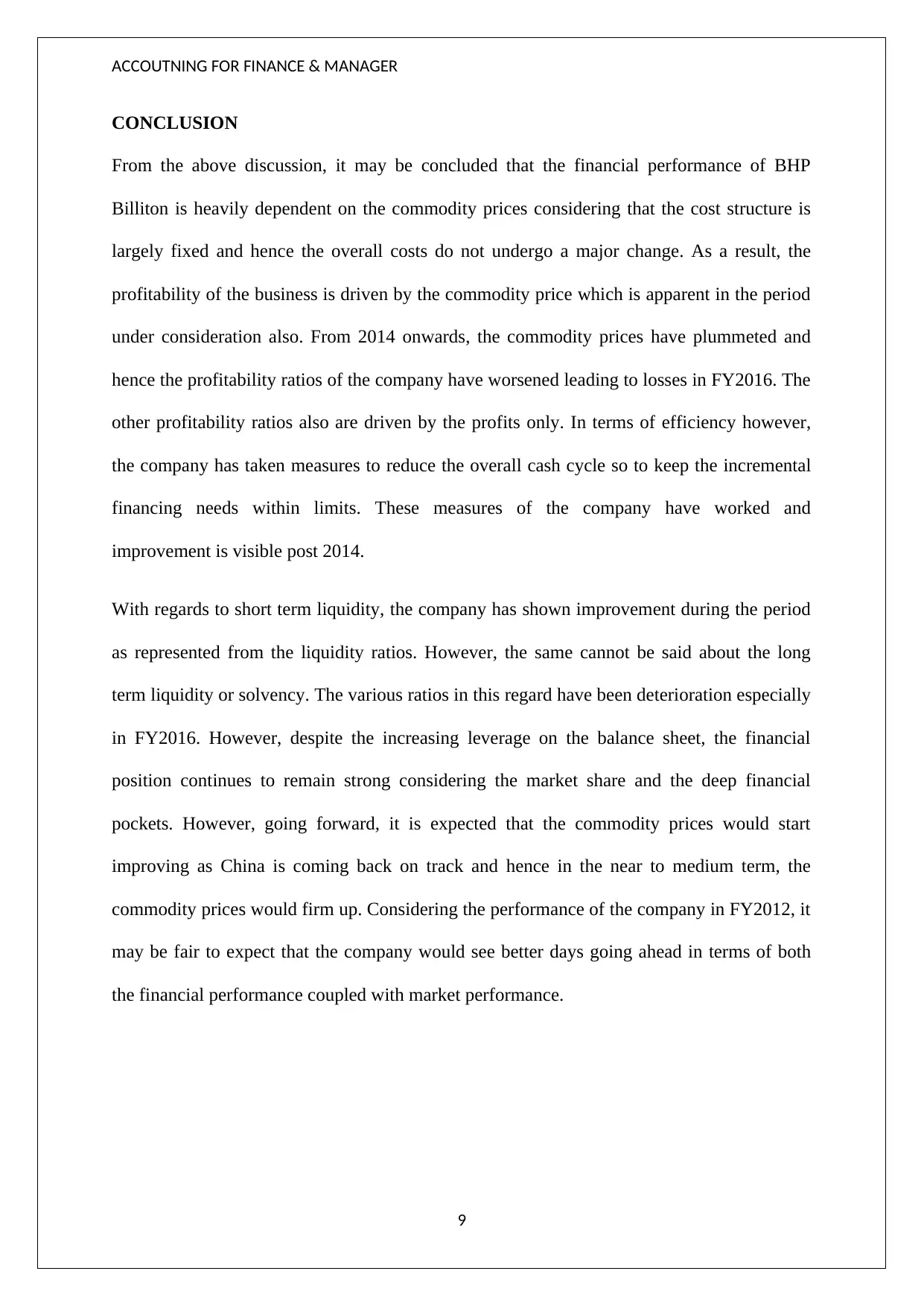
ACCOUTNING FOR FINANCE & MANAGER
CONCLUSION
From the above discussion, it may be concluded that the financial performance of BHP
Billiton is heavily dependent on the commodity prices considering that the cost structure is
largely fixed and hence the overall costs do not undergo a major change. As a result, the
profitability of the business is driven by the commodity price which is apparent in the period
under consideration also. From 2014 onwards, the commodity prices have plummeted and
hence the profitability ratios of the company have worsened leading to losses in FY2016. The
other profitability ratios also are driven by the profits only. In terms of efficiency however,
the company has taken measures to reduce the overall cash cycle so to keep the incremental
financing needs within limits. These measures of the company have worked and
improvement is visible post 2014.
With regards to short term liquidity, the company has shown improvement during the period
as represented from the liquidity ratios. However, the same cannot be said about the long
term liquidity or solvency. The various ratios in this regard have been deterioration especially
in FY2016. However, despite the increasing leverage on the balance sheet, the financial
position continues to remain strong considering the market share and the deep financial
pockets. However, going forward, it is expected that the commodity prices would start
improving as China is coming back on track and hence in the near to medium term, the
commodity prices would firm up. Considering the performance of the company in FY2012, it
may be fair to expect that the company would see better days going ahead in terms of both
the financial performance coupled with market performance.
9
CONCLUSION
From the above discussion, it may be concluded that the financial performance of BHP
Billiton is heavily dependent on the commodity prices considering that the cost structure is
largely fixed and hence the overall costs do not undergo a major change. As a result, the
profitability of the business is driven by the commodity price which is apparent in the period
under consideration also. From 2014 onwards, the commodity prices have plummeted and
hence the profitability ratios of the company have worsened leading to losses in FY2016. The
other profitability ratios also are driven by the profits only. In terms of efficiency however,
the company has taken measures to reduce the overall cash cycle so to keep the incremental
financing needs within limits. These measures of the company have worked and
improvement is visible post 2014.
With regards to short term liquidity, the company has shown improvement during the period
as represented from the liquidity ratios. However, the same cannot be said about the long
term liquidity or solvency. The various ratios in this regard have been deterioration especially
in FY2016. However, despite the increasing leverage on the balance sheet, the financial
position continues to remain strong considering the market share and the deep financial
pockets. However, going forward, it is expected that the commodity prices would start
improving as China is coming back on track and hence in the near to medium term, the
commodity prices would firm up. Considering the performance of the company in FY2012, it
may be fair to expect that the company would see better days going ahead in terms of both
the financial performance coupled with market performance.
9
Paraphrase This Document
Need a fresh take? Get an instant paraphrase of this document with our AI Paraphraser
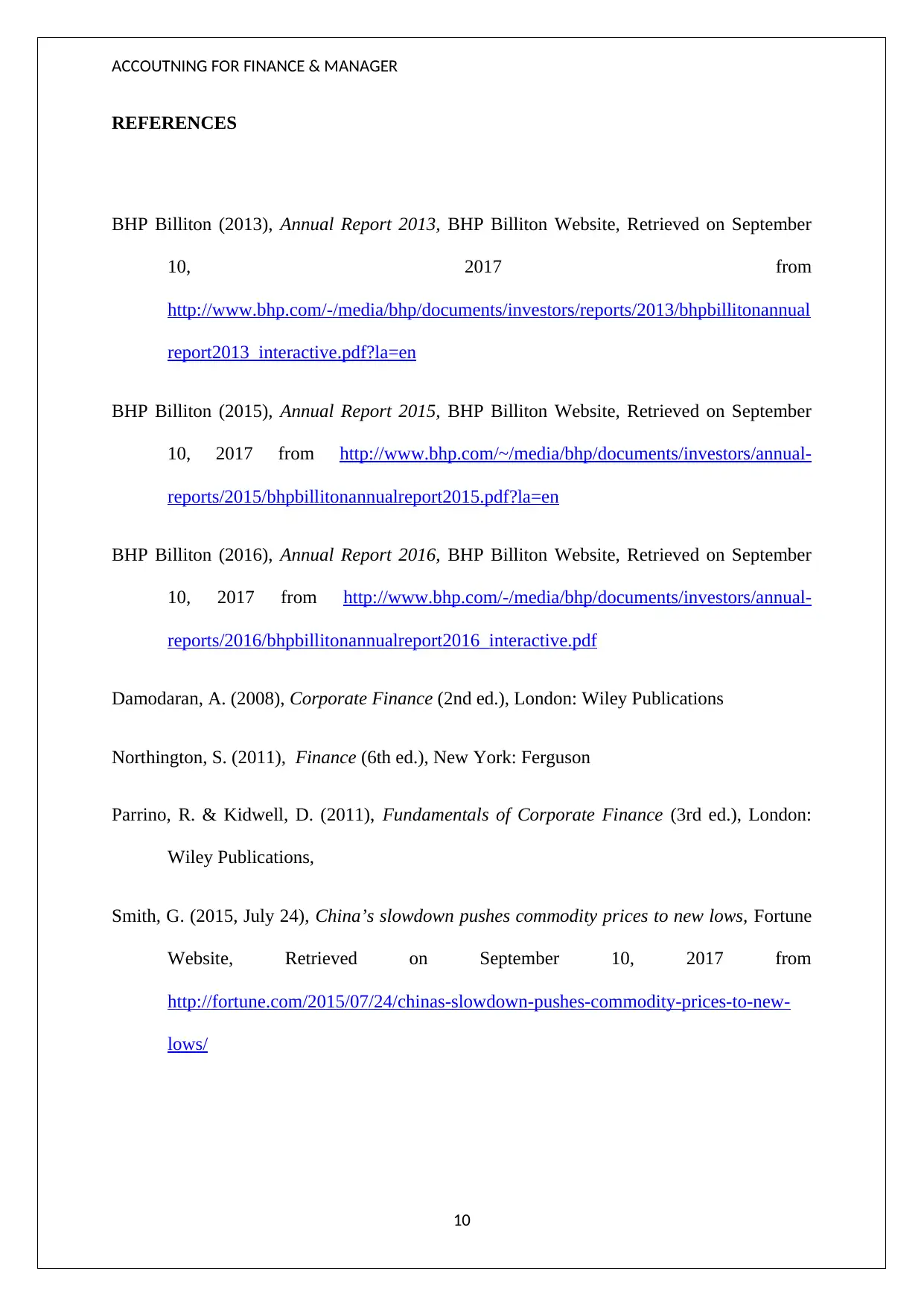
ACCOUTNING FOR FINANCE & MANAGER
REFERENCES
BHP Billiton (2013), Annual Report 2013, BHP Billiton Website, Retrieved on September
10, 2017 from
http://www.bhp.com/-/media/bhp/documents/investors/reports/2013/bhpbillitonannual
report2013_interactive.pdf?la=en
BHP Billiton (2015), Annual Report 2015, BHP Billiton Website, Retrieved on September
10, 2017 from http://www.bhp.com/~/media/bhp/documents/investors/annual-
reports/2015/bhpbillitonannualreport2015.pdf?la=en
BHP Billiton (2016), Annual Report 2016, BHP Billiton Website, Retrieved on September
10, 2017 from http://www.bhp.com/-/media/bhp/documents/investors/annual-
reports/2016/bhpbillitonannualreport2016_interactive.pdf
Damodaran, A. (2008), Corporate Finance (2nd ed.), London: Wiley Publications
Northington, S. (2011), Finance (6th ed.), New York: Ferguson
Parrino, R. & Kidwell, D. (2011), Fundamentals of Corporate Finance (3rd ed.), London:
Wiley Publications,
Smith, G. (2015, July 24), China’s slowdown pushes commodity prices to new lows, Fortune
Website, Retrieved on September 10, 2017 from
http://fortune.com/2015/07/24/chinas-slowdown-pushes-commodity-prices-to-new-
lows/
10
REFERENCES
BHP Billiton (2013), Annual Report 2013, BHP Billiton Website, Retrieved on September
10, 2017 from
http://www.bhp.com/-/media/bhp/documents/investors/reports/2013/bhpbillitonannual
report2013_interactive.pdf?la=en
BHP Billiton (2015), Annual Report 2015, BHP Billiton Website, Retrieved on September
10, 2017 from http://www.bhp.com/~/media/bhp/documents/investors/annual-
reports/2015/bhpbillitonannualreport2015.pdf?la=en
BHP Billiton (2016), Annual Report 2016, BHP Billiton Website, Retrieved on September
10, 2017 from http://www.bhp.com/-/media/bhp/documents/investors/annual-
reports/2016/bhpbillitonannualreport2016_interactive.pdf
Damodaran, A. (2008), Corporate Finance (2nd ed.), London: Wiley Publications
Northington, S. (2011), Finance (6th ed.), New York: Ferguson
Parrino, R. & Kidwell, D. (2011), Fundamentals of Corporate Finance (3rd ed.), London:
Wiley Publications,
Smith, G. (2015, July 24), China’s slowdown pushes commodity prices to new lows, Fortune
Website, Retrieved on September 10, 2017 from
http://fortune.com/2015/07/24/chinas-slowdown-pushes-commodity-prices-to-new-
lows/
10
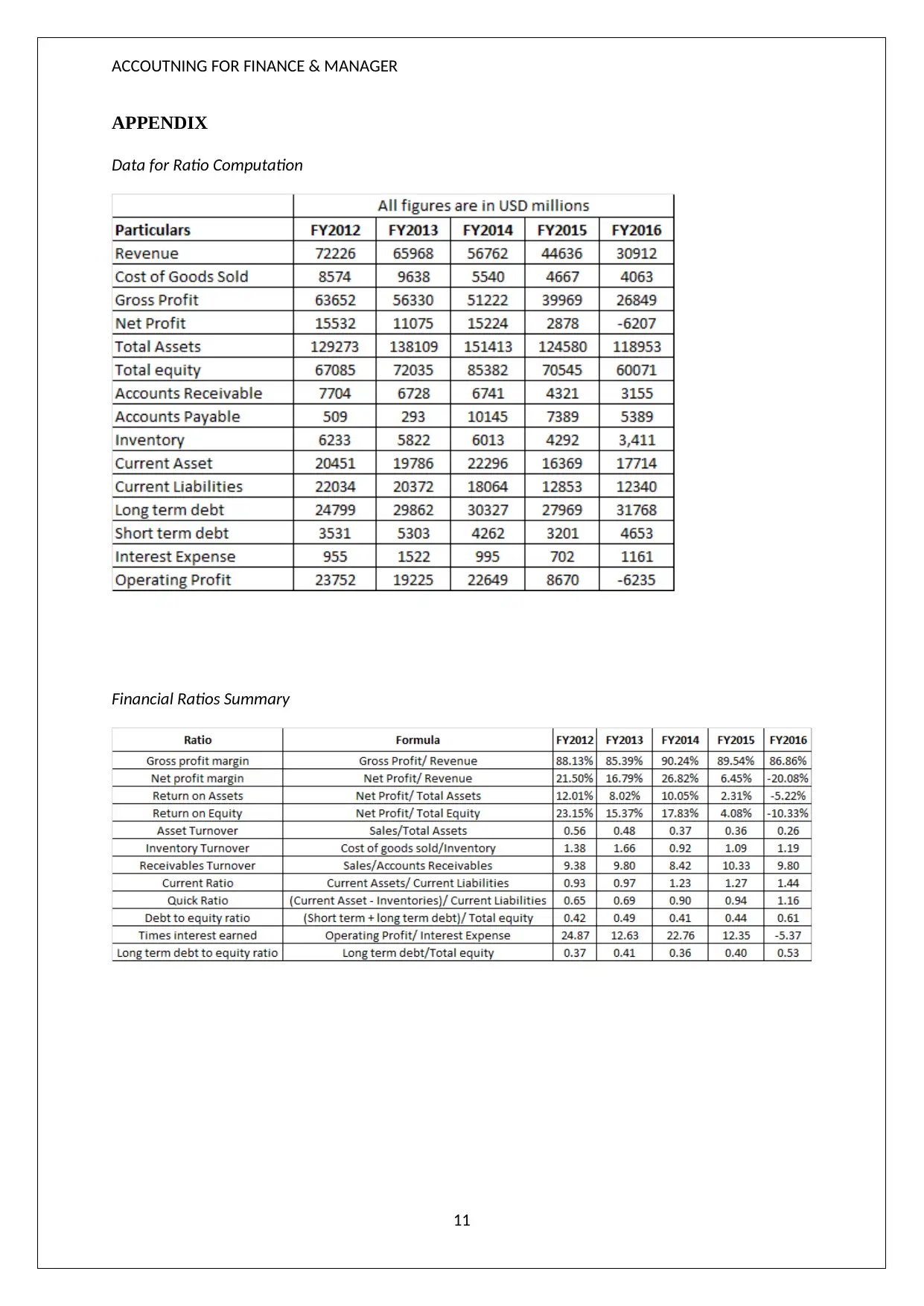
ACCOUTNING FOR FINANCE & MANAGER
APPENDIX
Data for Ratio Computation
Financial Ratios Summary
11
APPENDIX
Data for Ratio Computation
Financial Ratios Summary
11
⊘ This is a preview!⊘
Do you want full access?
Subscribe today to unlock all pages.

Trusted by 1+ million students worldwide
1 out of 12
Related Documents
Your All-in-One AI-Powered Toolkit for Academic Success.
+13062052269
info@desklib.com
Available 24*7 on WhatsApp / Email
![[object Object]](/_next/static/media/star-bottom.7253800d.svg)
Unlock your academic potential
Copyright © 2020–2025 A2Z Services. All Rights Reserved. Developed and managed by ZUCOL.




